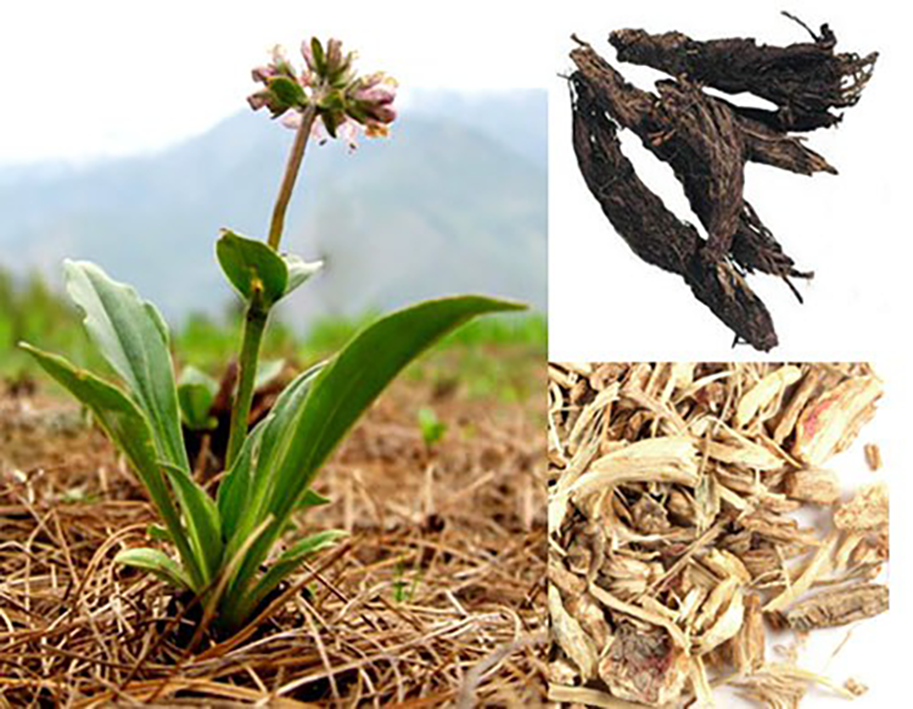FabulousFusionFood's Spice Guide for Spikenard Home Page
 Whole plant and
dried root of
spikenard,
Nardostachys
jatamansi.
Whole plant and
dried root of
spikenard,
Nardostachys
jatamansi.
Welcome to the summary page for FabulousFusionFood's Spice guide to Spikenard along with all the Spikenard containing recipes presented on this site, with 13 recipes in total.
This is a continuation of an entire series of pages that will, I hope, allow my visitors to better navigate this site. As well as displaying recipes by name, country and region of origin I am now planning a whole series of pages where recipes can be located by meal type and main ingredient. This page gives a listing of all the Cornish recipes added to this site.
These recipes, all contain as a major flavouring.
Spikenard, Nardostachys grandiflora or Nardostachys jatamansi (also known as Indian Spikenard, nard, nardin, jatmansi and muskroot) are two species of flowering plant belonging to the Valerianaceae (valerian) family. The plants are native to the Himalayas of China (Nardostachys jatamansi) and northern India and Nepal (Nardostachys grandiflora) and grow up to 1m tall with lanceolate leaves and pink, bell-shaped flowers. the plants are perennial herbs, with a stout un-branched or sparsely-branched woody aromatic rhizome, covered with reddish-brown thick fibers of remnants, a petiole of withered radical leaves with a single long tap root, typically with 2–7 rhizomes but sometimes up to 15. The flowers are borne on spikes from July to August and tend to be rose-purple to whitish in color and are found in dense heads at the terminus of the plant. The pant sets fruit in September and November.
The dried rhizome is the part of the plant used as a spice. This is very aromatic, and has been in use from ancient times. The Ancient Romans were particularly fond of spikenard (the dried and ground rhizome) as a spice, which they knew of as Spicam Indicam (Indian spikenard). It was also employed during the Middle Ages in both European and Arabic cuisines. Today, spikenard is most commonly used in perfumery, where an essential oil is derived from the rhizome of the plant. Dried spikenard rhizome can be obtained from specialist spice retailers.
This is a continuation of an entire series of pages that will, I hope, allow my visitors to better navigate this site. As well as displaying recipes by name, country and region of origin I am now planning a whole series of pages where recipes can be located by meal type and main ingredient. This page gives a listing of all the Cornish recipes added to this site.
These recipes, all contain as a major flavouring.
Spikenard, Nardostachys grandiflora or Nardostachys jatamansi (also known as Indian Spikenard, nard, nardin, jatmansi and muskroot) are two species of flowering plant belonging to the Valerianaceae (valerian) family. The plants are native to the Himalayas of China (Nardostachys jatamansi) and northern India and Nepal (Nardostachys grandiflora) and grow up to 1m tall with lanceolate leaves and pink, bell-shaped flowers. the plants are perennial herbs, with a stout un-branched or sparsely-branched woody aromatic rhizome, covered with reddish-brown thick fibers of remnants, a petiole of withered radical leaves with a single long tap root, typically with 2–7 rhizomes but sometimes up to 15. The flowers are borne on spikes from July to August and tend to be rose-purple to whitish in color and are found in dense heads at the terminus of the plant. The pant sets fruit in September and November.
The dried rhizome is the part of the plant used as a spice. This is very aromatic, and has been in use from ancient times. The Ancient Romans were particularly fond of spikenard (the dried and ground rhizome) as a spice, which they knew of as Spicam Indicam (Indian spikenard). It was also employed during the Middle Ages in both European and Arabic cuisines. Today, spikenard is most commonly used in perfumery, where an essential oil is derived from the rhizome of the plant. Dried spikenard rhizome can be obtained from specialist spice retailers.
The alphabetical list of all Spikenard recipes on this site follows, (limited to 100 recipes per page). There are 13 recipes in total:
Page 1 of 1
| Absinthum Romanum (Roman wormwood wine is made thus) Origin: Roman | Embamma in Cervinam Assam (Marinade for Roast Venison) Origin: Roman | Locusta Elixa cum Cuminato (Boiled Lobster with Cumin Sauce) Origin: Roman |
| Aliter Haedum sive Agnum Assum (Roast Kid or Lamb, Another Way) Origin: Roman | Gustato pro Caro (Sauce for Meat) Origin: Roman | Pullum elixum cum cucurbitis elixis (Ancient Roman Aniseed Chicken) Origin: Roman |
| Aliter in Echino (Sauce for Sea Urchin) Origin: Roman | In Omne Genus Conchyliorum (For All Kinds of Shellfish) Origin: Roman | Pur Fayte Ypocras (To Make Hippocras) Origin: England |
| Carnes Vaccinae (Byzantine Beef Stew) Origin: Roman | Ius in copadiis (Sauce for Choice Cuts) Origin: Roman | |
| Conditum Paradoxum (Extraordinary Spiced Wine) Origin: Roman | Ius Viride in Avibus (Green Sauce for Birds) Origin: Roman |
Page 1 of 1